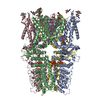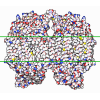[English] 日本語
 Yorodumi
Yorodumi- PDB-7or1: Cryo-EM structure of the human TRPA1 ion channel in complex with ... -
+ Open data
Open data
- Basic information
Basic information
| Entry | Database: PDB / ID: 7or1 | |||||||||
|---|---|---|---|---|---|---|---|---|---|---|
| Title | Cryo-EM structure of the human TRPA1 ion channel in complex with the antagonist 3-60, conformation 1 | |||||||||
 Components Components | Transient receptor potential cation channel subfamily A member 1 | |||||||||
 Keywords Keywords |  MEMBRANE PROTEIN / Transient receptor potential cation channel subfamily A member 1 / MEMBRANE PROTEIN / Transient receptor potential cation channel subfamily A member 1 /  Structural Genomics / Structural Genomics /  Structural Genomics Consortium / SGC Structural Genomics Consortium / SGC | |||||||||
| Function / homology |  Function and homology information Function and homology informationtemperature-gated cation channel activity / stereocilium bundle / detection of chemical stimulus involved in sensory perception of pain /  thermoception / thermoception /  TRP channels / channel activity / response to pain / cellular response to organic substance / intracellularly gated calcium channel activity / detection of mechanical stimulus involved in sensory perception of pain ...temperature-gated cation channel activity / stereocilium bundle / detection of chemical stimulus involved in sensory perception of pain / TRP channels / channel activity / response to pain / cellular response to organic substance / intracellularly gated calcium channel activity / detection of mechanical stimulus involved in sensory perception of pain ...temperature-gated cation channel activity / stereocilium bundle / detection of chemical stimulus involved in sensory perception of pain /  thermoception / thermoception /  TRP channels / channel activity / response to pain / cellular response to organic substance / intracellularly gated calcium channel activity / detection of mechanical stimulus involved in sensory perception of pain / monoatomic ion transport / sensory perception of pain / response to cold / response to organic substance / calcium ion transmembrane transport / TRP channels / channel activity / response to pain / cellular response to organic substance / intracellularly gated calcium channel activity / detection of mechanical stimulus involved in sensory perception of pain / monoatomic ion transport / sensory perception of pain / response to cold / response to organic substance / calcium ion transmembrane transport /  calcium channel activity / intracellular calcium ion homeostasis / response to organic cyclic compound / cellular response to hydrogen peroxide / protein homotetramerization / cell surface receptor signaling pathway / response to xenobiotic stimulus / identical protein binding / calcium channel activity / intracellular calcium ion homeostasis / response to organic cyclic compound / cellular response to hydrogen peroxide / protein homotetramerization / cell surface receptor signaling pathway / response to xenobiotic stimulus / identical protein binding /  plasma membrane plasma membraneSimilarity search - Function | |||||||||
| Biological species |   Homo sapiens (human) Homo sapiens (human) | |||||||||
| Method |  ELECTRON MICROSCOPY / ELECTRON MICROSCOPY /  single particle reconstruction / single particle reconstruction /  cryo EM / Resolution: 2.64 Å cryo EM / Resolution: 2.64 Å | |||||||||
 Authors Authors | Grieben, M. / Pike, A.C.W. / Saward, B.G. / Wang, D. / Mukhopadhyay, S.M.M. / Moreira, T. / Chalk, R. / MacLean, E.M. / Marsden, B.D. / Burgess-Brown, N.A. ...Grieben, M. / Pike, A.C.W. / Saward, B.G. / Wang, D. / Mukhopadhyay, S.M.M. / Moreira, T. / Chalk, R. / MacLean, E.M. / Marsden, B.D. / Burgess-Brown, N.A. / Bountra, C. / Schofield, C.J. / Carpenter, E.P. / Structural Genomics Consortium (SGC) | |||||||||
| Funding support |  United Kingdom, 2items United Kingdom, 2items
| |||||||||
 Citation Citation |  Journal: TO BE PUBLISHED Journal: TO BE PUBLISHEDTitle: Cryo-EM structure of the human TRPA1 ion channel in complex with the antagonist 3-60 Authors: Grieben, M. / Saward, B.G. / Pike, A.C.W. / Schofield, C.J. / Carpenter, E.P. | |||||||||
| History |
|
- Structure visualization
Structure visualization
| Structure viewer | Molecule:  Molmil Molmil Jmol/JSmol Jmol/JSmol |
|---|
- Downloads & links
Downloads & links
- Download
Download
| PDBx/mmCIF format |  7or1.cif.gz 7or1.cif.gz | 481 KB | Display |  PDBx/mmCIF format PDBx/mmCIF format |
|---|---|---|---|---|
| PDB format |  pdb7or1.ent.gz pdb7or1.ent.gz | 370.3 KB | Display |  PDB format PDB format |
| PDBx/mmJSON format |  7or1.json.gz 7or1.json.gz | Tree view |  PDBx/mmJSON format PDBx/mmJSON format | |
| Others |  Other downloads Other downloads |
-Validation report
| Arichive directory |  https://data.pdbj.org/pub/pdb/validation_reports/or/7or1 https://data.pdbj.org/pub/pdb/validation_reports/or/7or1 ftp://data.pdbj.org/pub/pdb/validation_reports/or/7or1 ftp://data.pdbj.org/pub/pdb/validation_reports/or/7or1 | HTTPS FTP |
|---|
-Related structure data
| Related structure data |  13037MC  7or0C M: map data used to model this data C: citing same article ( |
|---|---|
| Similar structure data | Similarity search - Function & homology  F&H Search F&H Search |
- Links
Links
- Assembly
Assembly
| Deposited unit | 
| |||||||||||||||||||||||||||||||||||||||||||||||||||||||||||||||||||||||||||||||||||||||||||||||||||||||||||||||||||||
|---|---|---|---|---|---|---|---|---|---|---|---|---|---|---|---|---|---|---|---|---|---|---|---|---|---|---|---|---|---|---|---|---|---|---|---|---|---|---|---|---|---|---|---|---|---|---|---|---|---|---|---|---|---|---|---|---|---|---|---|---|---|---|---|---|---|---|---|---|---|---|---|---|---|---|---|---|---|---|---|---|---|---|---|---|---|---|---|---|---|---|---|---|---|---|---|---|---|---|---|---|---|---|---|---|---|---|---|---|---|---|---|---|---|---|---|---|---|---|
| 1 |
| |||||||||||||||||||||||||||||||||||||||||||||||||||||||||||||||||||||||||||||||||||||||||||||||||||||||||||||||||||||
| Noncrystallographic symmetry (NCS) | NCS domain:
NCS domain segments:
|
 Movie
Movie Controller
Controller



 PDBj
PDBj






